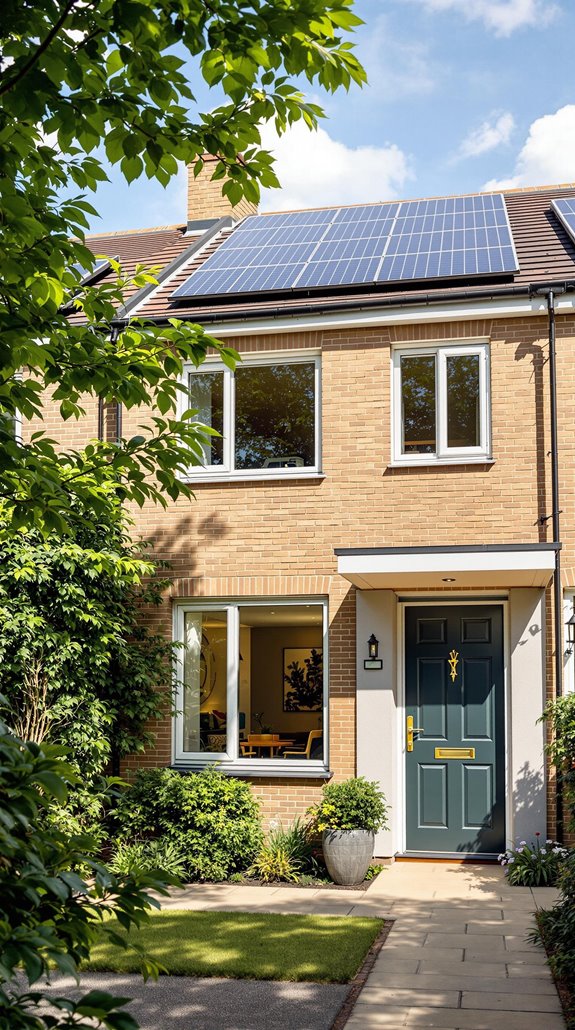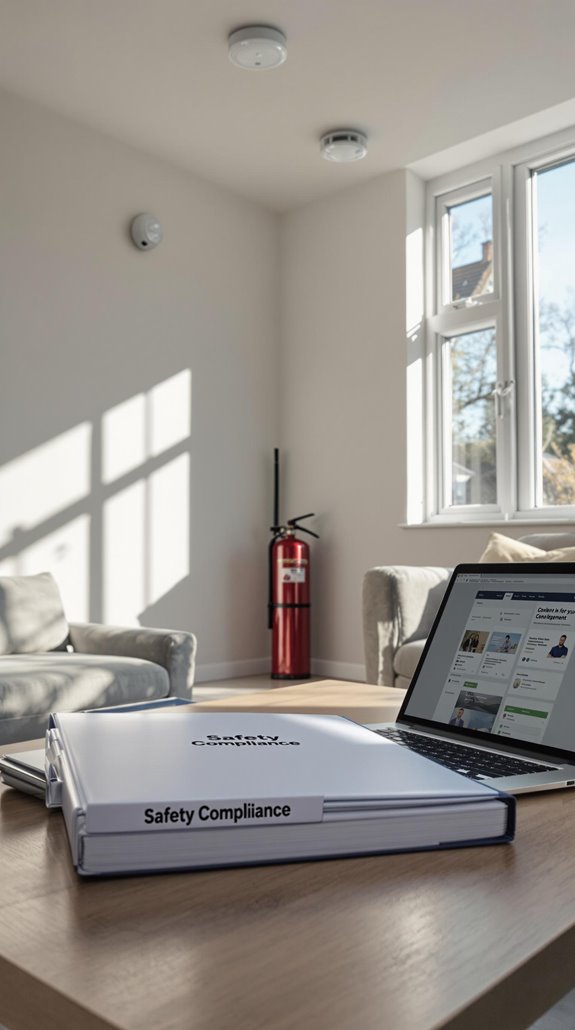I’ve helped countless UK live-in landlords transform their spare rooms into profitable rental income streams, and I can tell you the difference between struggling and succeeding comes down to understanding the legal framework first. Most landlords jump straight into advertising their space without grasping the licensing requirements, safety obligations, and tenant selection laws that’ll make or break their venture. Before you consider your first tenant, there’s a specific sequence of steps that’ll protect you from costly mistakes.
Key Takeaways
- Complete Right to Rent checks and obtain landlord insurance to ensure legal compliance and avoid penalties up to £30,000.
- Upgrade property with cost-effective improvements like insulation, modern kitchens, and energy-efficient features to justify higher rental rates.
- Achieve EPC ‘C’ rating by 2030 through high-impact upgrades to avoid fines and reduce vacancy periods significantly.
- Implement annual rent reviews using ONS data, limiting increases to 5-7% to retain quality tenants while maximizing income.
- Maintain contingency funds covering three months’ rent and use property management software to track financial performance effectively.
Understanding Your Legal Obligations as a Live-In Landlord

While live-in landlords face fewer regulations than traditional landlords, you’ll still need to meet essential legal requirements that protect both you and your tenants.
First, you must conduct Right to Rent checks, verifying your tenant’s immigration status with valid ID. I recommend creating a written tenancy agreement outlining rent, duration, and house rules – this protects everyone involved. Additionally, consider obtaining landlord insurance to safeguard your property against potential damages caused by tenants.
Safety compliance can’t be ignored. You’ll need annual gas safety checks by Gas Safe-registered engineers and working smoke alarms in common areas. While electrical safety certificates aren’t mandatory, they’re wise investments. Additionally, you must ensure any furnishings meet fire safety regulations to comply with product safety standards.
Under the Equality Act 2010, you can’t discriminate based on protected characteristics. Remember, you must allow quiet enjoyment of their space and provide reasonable notice before inspections. These obligations create a foundation for successful live-in arrangements.
Maximizing Rental Income Through Strategic Property Improvements
Since rental demand continues outpacing supply across the UK, strategic property improvements can substantially boost your rental income as a live-in landlord. I’ve found that 58% of landlords increased rents for new tenants in 2024, creating clear opportunities for those who invest wisely in their properties.
Focus on cost-effective upgrades that deliver immediate rental appeal. The government’s fabric-first policy actually works in your favor—prioritize insulation, windows, and doors before heating systems. These improvements justify higher rents while reducing your long-term maintenance costs. Remember that minimum EPC rating requirements mean energy efficiency upgrades aren’t just profitable—they’re essential for legal compliance. Additionally, understanding regional price variations can help you budget effectively for these improvements.
Modern amenities make the biggest difference. With 52% of landlords successfully increasing rents during renewals, upgraded kitchens, bathrooms, and energy-efficient features consistently command premium rates. Time your renovations during market growth periods when tenant demand peaks for maximum return on investment.
Energy Efficiency Upgrades That Boost Property Value and Reduce Costs

As energy regulations tighten across the UK, upgrading your rental property’s efficiency has shifted from optional to essential. You’ll need to achieve EPC ‘C’ rating by 2030 for all tenancies, with non-compliance resulting in £5,000-£30,000 fines. Incorporating energy-efficient upgrades not only enhances property value but also leads to significant energy consumption reductions.
I recommend starting with high-impact, cost-effective upgrades. Install loft and cavity wall insulation for £300-£600—this reduces heat loss by 25-30%. Upgrade to condensing boilers or heat pumps for 15-20% efficiency gains. Smart thermostats and LED lighting deliver 20% energy savings. Consider boiler cover to protect your heating system investment and ensure optimal performance throughout the compliance period.
The financial benefits are compelling. Average upgrade costs range £6,100-£6,800, but you’ll see increased rental income and faster tenant attraction. Properties rated EPC ‘C+’ reduce vacancy periods by 7-10 days while cutting tenant utility bills by £240 annually.
Navigating Tenant Selection and Anti-Discrimination Requirements
Before you can secure quality tenants, you must master the complex web of legal requirements governing tenant selection in today’s regulatory environment. I’ll guide you through the essential compliance steps that protect both you and your tenants.
You’re now required to conduct biometric ID verification and Right-to-Rent checks for every applicant. Don’t skip employment history verification or previous landlord references – these reveal reliability patterns. Anti-Money Laundering screening has become mandatory for financial risk assessment.
Remember, “No DSS” policies are illegal under the Renters’ Rights Bill. You must base decisions on objective affordability metrics, not personal characteristics. When tenants request pets, provide documented refusals with valid reasons like insurance restrictions. Additionally, maintaining a positive landlord-tenant relationship can help in mitigating potential disputes even before they arise.
Maintain auditable decision trails – with Section 21 evictions abolished, initial tenant selection faces heightened scrutiny and potential Tribunal challenges. The court backlogs mean that once you’ve selected a tenant, resolving any future disputes will take significantly longer than before.
Essential Safety Compliance and Documentation Management

While tenant selection sets the foundation for successful lettings, thorough safety compliance and meticulous documentation management will determine whether your property investment survives regulatory scrutiny and potential legal challenges.
I’ll break down the non-negotiable requirements you must master. Annual gas safety checks by Gas Safe registered engineers aren’t optional—retain certificates for two years minimum. Your EICR needs renewal every 3-5 years, with Category 1 hazards addressed within 14 days. Don’t forget the EPC with a minimum Band E rating, valid for ten years unless you’re renovating. It’s also essential to consider any hidden costs that may arise during the selling process, as unexpected expenses can affect your overall profitability.
HMO properties require additional licensing and fire risk assessments. I recommend bi-annual property inspections with timestamped photos and tenant acknowledgments. Since 2025, you’ll need to screen all parties against the UK Consolidated List. These aren’t suggestions—they’re your legal armor. Remember that tenant deposits must be secured in a government-approved deposit protection scheme within 30 days of receipt.
Smart Rent Management and Pricing Strategies
Setting your rent correctly will make or break your property investment returns, yet most landlords rely on guesswork rather than data-driven strategies. I recommend analyzing Rightmove and Zoopla listings to benchmark your property against comparable rentals in your area. Consider location, condition, and amenities when positioning your price—avoid overpricing that creates extended vacancies or underpricing that sacrifices income. Additionally, consider how energy-efficient solutions can enhance your property’s appeal and justify higher rent.
I conduct annual rent reviews using ONS rental data and local market trends, limiting increases to 5-7% to retain quality tenants. Include review clauses in your tenancy agreements and communicate changes 60-90 days before renewal.
Implement automated rent collection through digital platforms and enforce late-payment penalties consistently. Professional property management services can handle these administrative tasks while ensuring compliance with current regulations and maximizing your rental returns. Track your income and expenses using property management software, and maintain contingency funds covering three months’ rent for unexpected repairs.
Licensing Requirements and Administrative Best Practices

Although many live-in landlords assume they’re exempt from licensing requirements, the reality is far more complex and depends on your specific circumstances and local council regulations.
First, I’ll help you determine if you need a licence. Check your local council’s website for selective licensing schemes in your area. If you’re housing three or more unrelated tenants who share facilities, you’ll likely need HMO licensing. Don’t guess—verify directly with your council.
When applying, prepare essential documents: proof of ownership, gas safety certificates, and electrical reports. Budget £500-£1,500 per property and allow 8-12 weeks for processing. Councils also conduct background checks on landlords to ensure property quality standards are maintained, which is crucial to avoid landlord fines in the future.
Stay compliant by maintaining valid safety certificates and keeping detailed records. Non-compliance isn’t worth the risk—penalties reach £30,000, and you can’t collect rent or serve eviction notices without proper licensing.
Conclusion
I’ve covered the essential strategies you’ll need to maximize your rental income as a live-in landlord. Focus on cost-effective improvements, maintain strict safety compliance, and implement thorough tenant screening processes. Don’t forget to utilize property management software for efficient operations and regularly review market rates for competitive pricing. By following these technical approaches and staying current with legal requirements, you’ll optimize your rental returns while minimizing risks and administrative burdens.
References
- https://www.houseandson.net/blog/a-landlords-guide-to-new-rental-legislation-in-2025
- https://theindependentlandlord.com/landlords-2025/
- https://www.ashmoreresidential.com/ar-news/key-changes-for-uk-landlords-in-2025-what-you-need-to-know/
- https://www.totallandlordinsurance.co.uk/knowledge-centre/key-dates-for-landlords
- https://www.cia-landlords.co.uk/advice/what-are-the-new-rules-for-landlords/
- https://blog.openrent.co.uk/difference-between-landlord-and-live-in-landlord/
- https://scotland.shelter.org.uk/housing_advice/tenants_rights/resident_landlord
- https://www.landlordvision.co.uk/blog/live-in-landlord-responsibilities/
- https://www.cia-landlords.co.uk/advice/what-is-a-live-in-landlord/
- https://www.hybr.co.uk/landlords/blog/what-must-a-landlord-provide-by-law-in-the-uk

